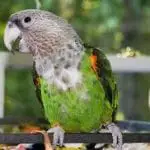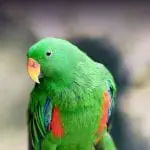Scientific Facts
| Common Name | Dusky Parrot |
| Scientific Name | Pionus fuscus |
| Origin | Northern South America, Northeastern Amazon Basin, Southeast Amazon Basin, northwest Maranhão state Brazil and in the Guiana countries; There is a limited sighting of their population in the west in central-eastern Venezuela, eastern side, Orinoco River, and on the Caribbean coast |
| Habitat | humid lowland forest; thrive in as high as 1200 meters from the ground |
| Diet | seeds from fruits and vegetables, nuts and flowers |
| Size and Weight | 24-26 cm (9-11 in) long and weigh around 8 ounces (220 grams) max |
| Lifespan | Wild: 3-10 years Captivity: up to 40 years |
Physical Description
The dusky parrot or also known as the dusky pionus is described as a medium-sized parrot that has an overall dark brownish-gray color that is spread throughout its body. As its name implies, it does not have a vibrant tone overall shading, but its body has colorful highlights of violet, pink, red, and blue. They are characterized to have a medium-wide gray eye-ring that fades as it grows older, a splash of cream-white on its upper neck feathers, a combination of red and blue on its tail, and a tinge of the pinkish-red belly.
The have a dark grey bill with a yellow base that matches its overall color. There are no distinguishing marks of males from females; that is why DNA testing is required for you to know their gender. Their mellow colors and subtle little details make them unique in a simple but charming way.
Where it is Seen?
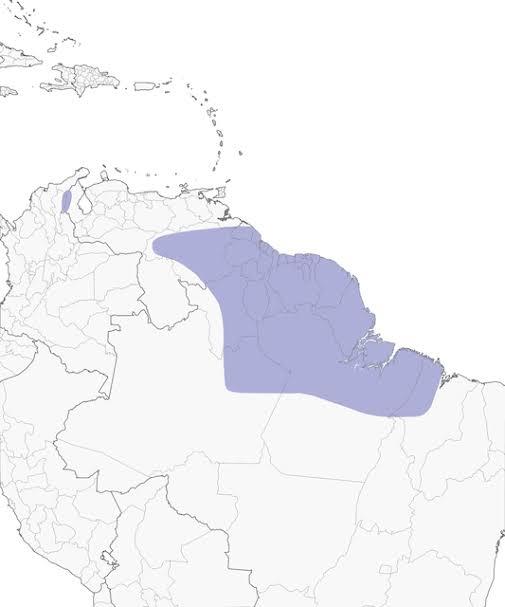
The dusky parrot is common to northern South America, Northeastern Amazon Basin, Southeast Amazon Basin, northwest Maranhão state Brazil and in the Guiana countries. There is a limited sighting of their population in the west in central-eastern Venezuela, eastern side, Orinoco River, and on the Caribbean coast.
Habitat
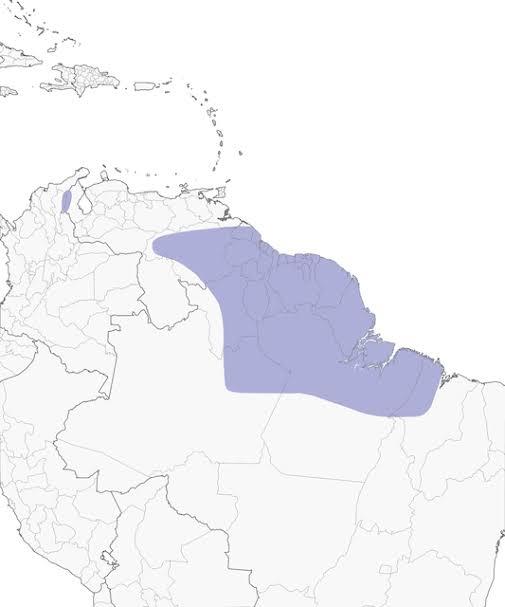
The dusky parrot’s habitat is in the humid lowland forest where they can easily hide among the foliage of plants and trees. They are nesting parrots that can thrive in as high as 1200 meters, where they are shielded from their predators and hunters.
Behavior and Temperament
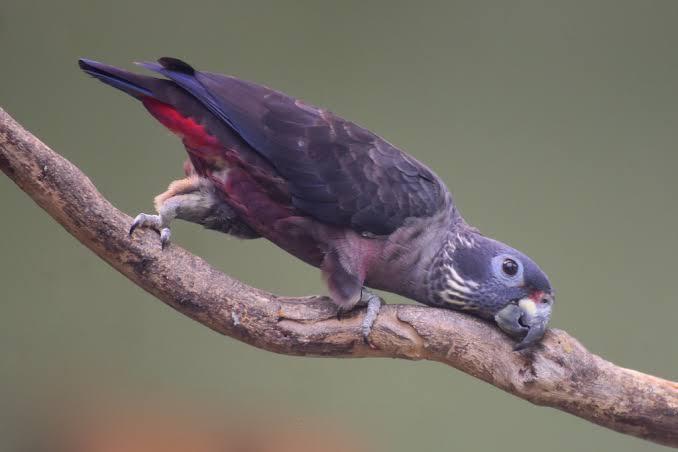
The dusky parrots are not known to be a highly vocal talking parrot just like other parrot species, but they can be trained patiently for them to utter at least 10-20 words. They have a reputation for being quiet, making them a perfect captive bird. This species greatly depend on social interaction; when they are alone, you will notice that they will become noisy just to get attention because when they feel neglected, they will develop behavioral problems that may lead to death. It is advisable to place at least two dusky parrots in one cage, but it is not advisable to place the bird species in their cage because they can be aggressive.
Breeding and Reproduction
The dusky parrot nest in tree cavities where their eggs won’t be disturbed. The breeding season starts in February or March and ends in June or July. They are considered sexually mature when they reach the ages of 3-5 years old. They can lay up to 3 or 4 clutches of eggs. The females are the only ones who will incubate it for about 26 days while the males look for food. At around 70 days old, the chicks are ready to have their first flight.
The dusky parrot is quite difficult to breed in captivity; that is why it is important to make sure that both birds are accustomed to the presence of each other before the mating process takes place. It is the male that tends to be aggressive during the mating process; that is why a procedure that breeders make is to clip their wings so that when they are aggressive while mating, the females can easily escape. There should be a nest box with dimensions of 10″ wide x 10″ deep x 18-24″ high situated on top of the cage.
Diet
In the wild, the dusky parrot eats seeds from fruits and vegetables, nuts, and flowers. In captivity, you must give them diet mixes or supplement food mix for them to get the nutritional value you needed on a daily basis. In captivity, they given cuttlebone to support the vitamins and minerals that they needed on a daily basis.
Size and Weight
The adult dusky parrot reaches an average of approximately 24-26 cm (9-11 in) long and weighs around 8 ounces (220 grams) max.
Lifespan
The dusky parrot has a short lifespan in the wild due to different reasons such as loss of habitat, poor nutrition, and accidents. It is believed that their average lifespan in the wild is about 3-10 years, while in captivity since the different factors affect their lifespan is controllable, they can live up to 40 years.
Common Diseases/Illnesses
- Psittacosis in Birds (Parrot fever)
Parrot fever is also known as chlamydophila, psittacosis, or ornithosis. It is an infectious disease that infests parrot species. It is spread out through the bird’s droppings or from their dust. These are the symptoms of Psittacosis disease: lack of appetite, depression, difficulty breathing, mucus discharge from eyes, and nose and Watery, green droppings.
If you see just one symptom, take it immediately to your veterinarian because it can cause sudden death of your bird if it is not treated immediately. Antibiotic treatment to kill the bacteria is necessary. You need to be cautious in handling them if you see some symptoms because psittacosis is contagious to humans that will bring very flu-like symptoms.
- Polyomavirus
This infectious disease is common to both mammals and aviary. The impact of polyomavirus on the golden conure is fatal, especially to juveniles, because it directly impacts their immunity. If the bird has enough immunity to fight the infection, there is a higher chance that your conure would be able to survive. Research shows that the older the conure is, the more it develops immunity. It is not contagious to humans, but it can the disease can be transferable to other birds through their droppings and if humans touch an infected bird and then hold another bird.
Conure species are more prone to polyomavirus among the parrot species. The symptoms of polyomavirus are loss of appetite, vomiting, diarrhea, dehydration, weight loss, and swollen abdomen. There is no cure for this disease; once the bird gets infected, the bird will be weak slowly and soon die. There is a vaccination to avoid this disease, but it is advisable to do it before the bird develops its wings. Make sure that the environment where you would take your pet is always hygienic.
- Pacheco’s disease
This is caused by a herpes virus that can be spread easily through nasal discharge and feces. It is not contagious to humans, but birds are more susceptible to this disease if they are stressed or depressed, especially over the loss of their cage mate. The symptoms of this disease are sinusitis. Lethargy, tremors, anorexia, and green droppings. These symptoms may often lead to sudden death. There is an antiviral drug that is used to combat this disease, but its side effects can cause kidney damage; that is why quarantine is a preventative measure.
- Giardia
This is an intestinal infection that is caused by parasites. When the bird is infected with this disease, their feces have cysts that van be contagious to other birds. Your bird is susceptible to this disease if the food that you are giving to them, as well as the water sources, are dirty. It is also contagious to humans if the water supply that they drink is the same as the bird. Giardia symptoms to golden conures are dry itching skin, diarrhea, bulky stools, weight loss, and depression.
- Malnutrition
The most common diseases or illnesses are usually due to malnutrition. If your pet is enriched with nutrients, it is less likely that they will be infested with different illnesses. Malnutrition leads to lower immunity. Making sure that you are providing your conure with the right nutrients is complicated; that is why you may need to check the bird supplements guide so as to be accurate in giving them a balanced diet. Aside from the nutrients from their food, they should also be exposed in full-spectrum sunlight. A sign that your pet has a nutritional deficiency is when there is a change in their physical appearance, such as feather stress bars, and shows weakness.
- Proventricular Dilatation Disease (PDD)
This disease directly affects the nerves of the bird that supply to different organs of their body, especially in the gastrointestinal tract. This is also known as the Macaw Wasting Syndrome and Parrot Wasting Syndrome because this disease is commonly seen in Macaws, Amazon parrots, cockatoos, African grey parrots, and conure species.
The symptoms of Proventricular Dilatation Disease are vomiting, weight loss, swollen muscular pouch near the throat, and changes in the consistency of the texture of their droppings. Nonsteroidal anti-inflammatory drugs are known to regulate this disease and that it is necessary to give them a special diet provided by the veterinarian. There is no cure for this disease, but the give drugs are to reduce the pain the bird is experiencing to avoid irritations.
- Psittacine Beak and Feather Disease (PBFD)
This is a serious disease that affects all the members of the parrot species; that is why it is referred to as the bird AIDS because AIDS seen on humans almost has the same symptoms. Birds that are under two years old are more susceptible to disease, but it can affect all birds at any age. The symptoms of Psittacine Beak and Feather Disease include abnormal feather development, feather loss, abnormalities of the beak, and lesions on their skin. The veterinarian may conduct skin and/or feather biopsy and some supportive care to alleviate their pain.
- Ulcerative dermatitis
This is a skin disease that can easily irritate the parrot. A sign that they are irritable is when they peck their skin that eventually leads to wounds and breakage. It brings itchiness and stinging sensations. When you see that your parrot has an open wound, make sure to do first aid so that it won’t be infected. There are ointments that can ease irritations.
- Avian pox
This viral disease is known to infect at least 60 species of birds, including the white-bellied parrot. The symptoms lesions on the unfeathered parts of their body, such as their eyelids, feet, legs, and around the beak and mouth area. In many cases, birds die when they have difficulty opening their eyes and locating their food due to eyesores. This is easily spread when mosquitoes feed on the blood of an infected bird and transfer to a healthy bird.
- Overweight parrot
When the parrot looks fat, it doesn’t mean that they are healthy. Being fat is next to being overweight or obese, which is an unhealthy physical physique for a bird because it can be a cause of different diseases or illnesses. Overweight is due to an improper way of feeding them, may it be the schedule of feeding or the variety of foods that are given to them. The more healthy options, the less likely that they’ll be overweight. If your parrot’s body is too heavy, they’ll have difficulty moving, restricting them from moving properly. You may need to consult your veterinarian for the list of foods that can be given to them, just avoid sugary and fatty-based diets.
- Avian Gastric Yeast (AGY) infection (megabacteriosis)
This disease targets the ability of your parrot to digest food because of the bacterial and yeast infection leading to weight loss. It is quite difficult to identify if your parrot has an Avian Gastric Yeast (AGY) infection (megabacteriosis), especially during the first phases because your parrot will not lose weight at once. You may need to observe them carefully. As soon as you see undigested food from their feces or vomit, this is already a sign that they have a problem digesting it. Your veterinary would advise you to give them antibiotics for about a week so as to kill the bacteria and replace the good cells that had been infested.
- Feather Picking and Self-mutilation
Feather Picking and self-mutilation are usually due to behavioral problems caused by boredom, stress, and sexual frustration. As soon as your bird learns this behavior, it can no longer be unlearned; that is why when you notice unusual behavior from your bird, take it immediately to your veterinarian. This behavior is usually triggered if your bird is lonely and bored; that is why it is always important to make them feel that they are not alone by playing with them, or you can have them in pairs.
Captive Breeding
The dusky parrots have a stable population both in captivity and in the wild; that is why they are common to be petted in captivity. They have a wonderful temperament, and that they are low-maintenance, that is why it is a suitable parrot species for beginners. As long as their basic needs are given, except that it will be easier for them to achieve their expected lifespan.
Availability-Where to Get One?
Since their population is not tagged to be threatened, they can be commonly seen in pet shops, and breeders usually have this type of parrot species. They can also easily availed through personal breeders online.
How to Care Parrot as a Pet?
- Housing
The dusky parrot is less demanding and is easier to care for compared to other parrot species, especially when it comes to their housing, but of course, you should still give what is ideal for them. A large cage is always the best environment for them so that they can easily move and do their activities. Their cage should be equipped with different kinds of chewable toys, perches, swings, and other accessories so that they won’t get bored and frustrated, especially if you are not around to play with them personally.
- Feeding
One of the factors that contribute to the lifespan of dusky parrots is their diet. If they are given healthy, nutritious, and high-quality food all the time, your bird can avoid different kinds of diseases or illnesses that will extend their lifespan. In captivity, they should be fed with commercial seed and pellet mix that is already enriched with nutrients and minerals. Their diet should also be supplemented with fresh fruits and vegetables that aids in increasing their immunity.
You can give them a varied diet as long as it is approved by your veterinarian. They should also be fed at the same time every day to avoid any digestive problems. Avoid giving them fatty and sugary foods because it may be a cause of overweight and obesity. There is also a tendency that your bird will become a picky eater, so try experimenting types of food mixes.
- Exercise
The dusky parrots should be encouraged to come out of the cage and exercise for a minimum of 2 or 4 hours each day; that is why before taking them into captivity, you should devote your time in taking good care of their welfare. Taking them out of their cage is important, especially for those birds that are placed in small cages where they cannot fully fly and do some of their activities. Before letting them out of their cage, make sure that the place where they will fly is a bird-proof area.
- Grooming
The dusky parrot easily gets irritated; that is why it is important to do grooming. You need to bathe or shower them at least once a week. Most species of parrots, especially the dusky parrots are fond of water, sometimes they even dive into the bowl of their drinking water that is why it is important to give them a water bowl that only has a sufficient water for drinking because they can drown for only a couple of inches deep and that they are not good at swimming.
A proper way for you to bathe them is through the use of a showerhead or a can with small holes. To know if your bird is comfortable with water, just sprinkle them a little bit first, if they show some signs of aggressiveness, it means that they do not like to take a bath so don’t force it. Apart from bathing them, you also need to trim their claws and nails. Some pet owners are not comfortable doing it, so you may visit your veterinarian to groom them safely and correctly.
Conservation Status
The dusky parrot is still common throughout its range. They were tagged by the IUCN Red List as least concern because their population is still stable even though they are factors that decrease their population. It is a common captive bird where owners usually breed, thus further increases their population.
FAQ Section
Are dusky parrot color blind?
There is a misconception that they are color blind, but actually, studies show that they have better vision than human beings because they have a total of four light-sensitive pigments that is situated in their retina while humans only have three pigments. The ray of light is invisible to the human eyes, but for these parrots, the light is part of the colors that are visible to them.
What smell do dusky parrot hate?
Most of the parrot species hate the smell of peppermint oil and citronella. These are the most common essentials at home, so be sure that they do not use these oils near their cage because it may highly cause irritations.
Where does dusky parrot go when it’s raining?
Their feathers play an important role in making their bodies warm during the rainy season so even though they are wet, they won’t feel the coldness right away but however, when it is heavily raining, they seek shelter from the plant or tree’s bushes, and they tend to have no physical activity to conserve their energy.
How can you tell if a dusky parrot is stressed?
There are manifestations to tell if your parrot is stressed, but the most common manifestations are when they create a loud noise and when they raise their wings away from their bodies. If you see these actions, spend time with them because there is just a possibility that they are just seeking attention.
How do I know if my dusky parrot is happy?
If your parrot is excited and happy, they may also be noisy, but you will notice that their bodies are relaxed and that their crest is flat.
Is dusky parrot high maintenance?
They are high maintenance in such a way that they need your attention every day. You must feed and give them water and food every day. They are a hardy type of parrot as long as they are staying in a clean and ideal environment.
How long can a dusky parrot be left alone?
It is not advisable to leave them for a long time because of their need for human attention. Don’t leave them for more than 10 hours, and make sure that you have time for them to mingle every day.


